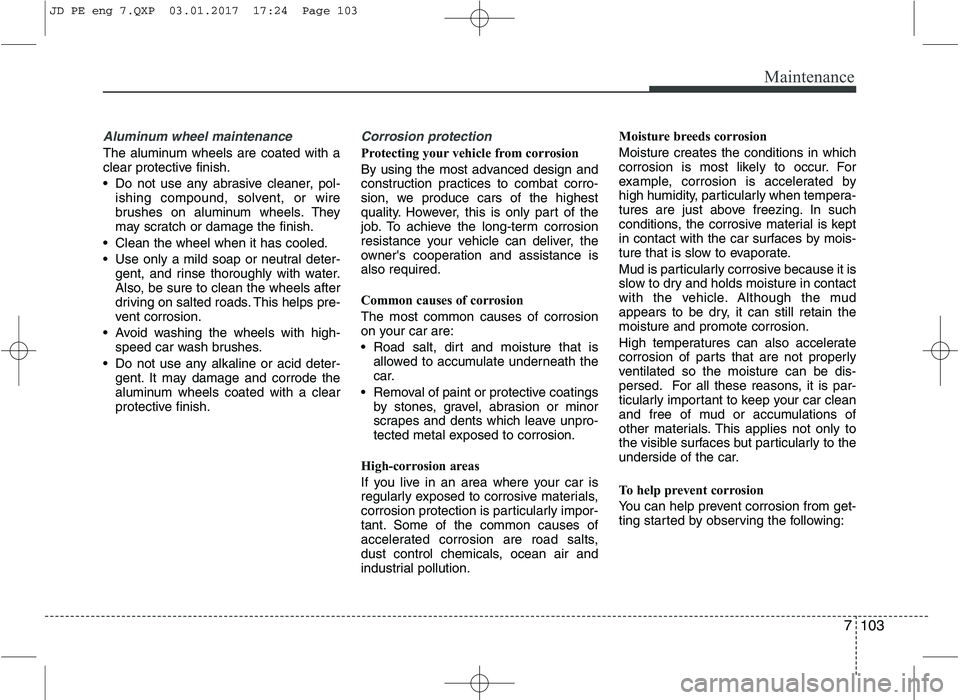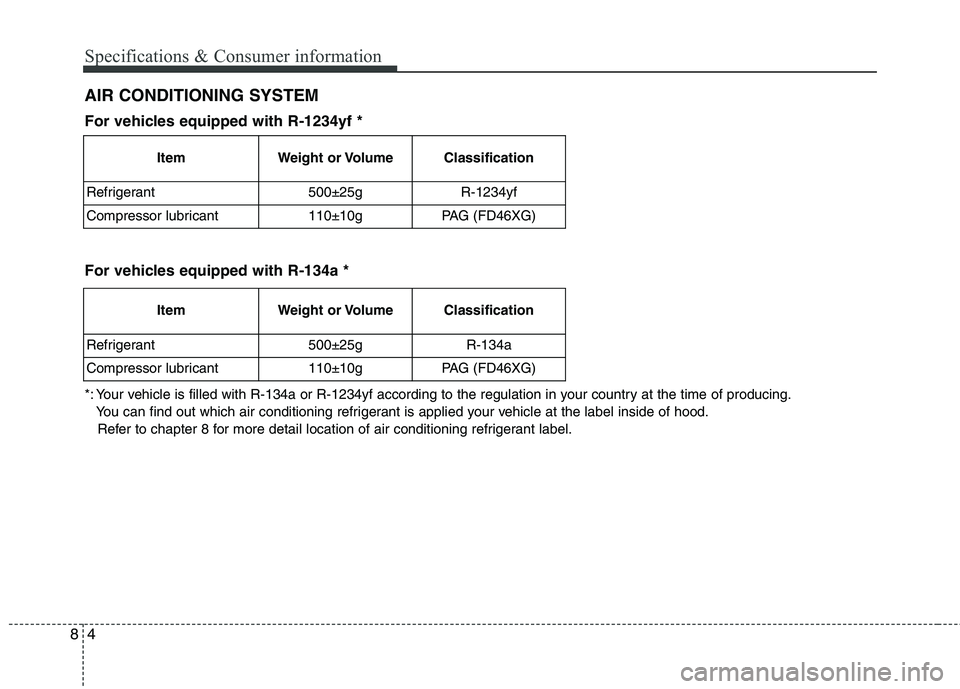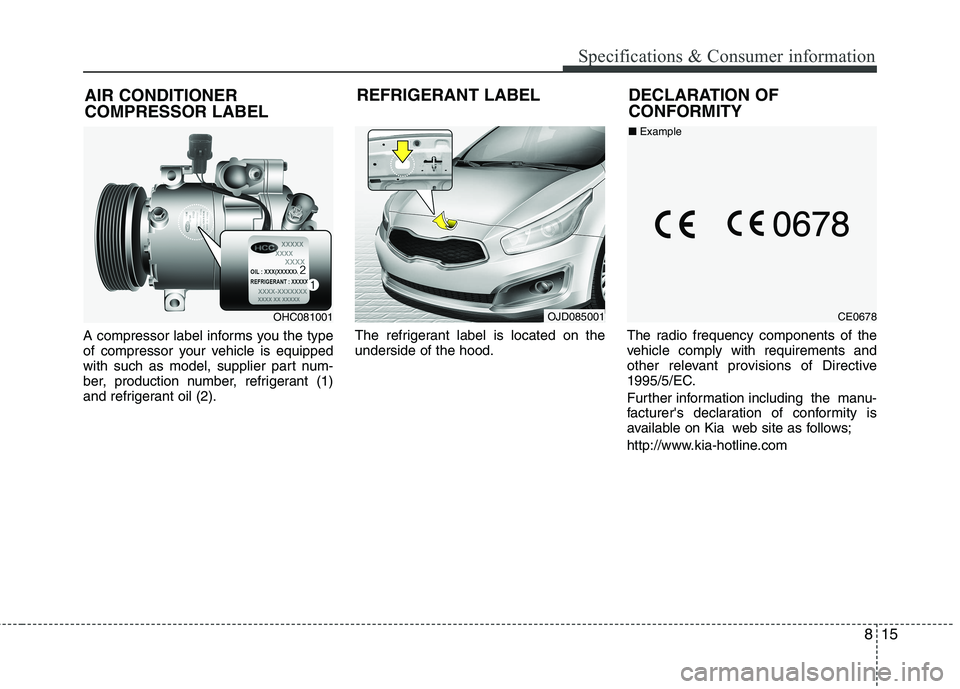2017 KIA CEED air condition
[x] Cancel search: air conditionPage 573 of 653

755
Maintenance
Low aspect ratio tire (if equipped)
Low aspect ratio tires, whose aspect
ratio is lower than 50, are provided
for sporty looks.
Because the low aspect ratio tires
are optimized for handling and brak-
ing, it may be more uncomfortable to
ride in and there is more noise com-
pare with normal tires.CAUTION
Because the sidewall of the lowaspect ratio tire is shorter thanthe normal, the wheel and tire of the low aspect ratio tire is easi-er to be damaged. So, follow theinstructions below.
- When driving on a rough road or off road, drive cautiouslybecause tires and wheels maybe damaged. And after driving,inspect tires and wheels.
- When passing over a pothole, speed bump, manhole, or curbstone, drive slowly so that thetires and wheels are not dam-aged.
- If the tire is impacted, we rec- ommend that you inspect thetire condition or contact anauthorized Kia dealer.
- To prevent damage to the tire, inspect the tire condition andpressure every 3,000km.
CAUTION
It is not easy to recognize the tire damage with your owneyes. But if there is the slight- est hint of tire damage, eventhough you cannot see the tiredamage with your own eyes, have the tire checked orreplaced because the tiredamage may cause air leak- age from the tire.
If the tire is damaged by driv- ing on a rough road, off road,pothole, manhole, or curbstone, it will not be covered by the warranty.
You can find out the tire infor- mation on the tire sidewall.
JD PE eng 7.QXP 03.01.2017 17:19 Page 55
Page 621 of 653

7103
Maintenance
Aluminum wheel maintenance
The aluminum wheels are coated with a
clear protective finish.
Do not use any abrasive cleaner, pol-ishing compound, solvent, or wire
brushes on aluminum wheels. They
may scratch or damage the finish.
Clean the wheel when it has cooled.
Use only a mild soap or neutral deter- gent, and rinse thoroughly with water.
Also, be sure to clean the wheels after
driving on salted roads. This helps pre-
vent corrosion.
Avoid washing the wheels with high- speed car wash brushes.
Do not use any alkaline or acid deter- gent. It may damage and corrode the
aluminum wheels coated with a clear
protective finish.
Corrosion protection
Protecting your vehicle from corrosion
By using the most advanced design and
construction practices to combat corro-
sion, we produce cars of the highest
quality. However, this is only part of the
job. To achieve the long-term corrosion
resistance your vehicle can deliver, the
owner's cooperation and assistance isalso required.
Common causes of corrosion The most common causes of corrosion
on your car are:
allowed to accumulate underneath the
car.
Removal of paint or protective coatings by stones, gravel, abrasion or minor
scrapes and dents which leave unpro-
tected metal exposed to corrosion.
High-corrosion areas
If you live in an area where your car is
regularly exposed to corrosive materials,
corrosion protection is particularly impor-
tant. Some of the common causes of
accelerated corrosion are road salts,
dust control chemicals, ocean air and
industrial pollution. Moisture breeds corrosion Moisture creates the conditions in which
corrosion is most likely to occur. For
example, corrosion is accelerated by
high humidity, particularly when tempera-
tures are just above freezing. In such
conditions, the corrosive material is kept
in contact with the car surfaces by mois-
ture that is slow to evaporate.
Mud is particularly corrosive because it is
slow to dry and holds moisture in contact
with the vehicle. Although the mud
appears to be dry, it can still retain themoisture and promote corrosion.
High temperatures can also accelerate
corrosion of parts that are not properly
ventilated so the moisture can be dis-
persed. For all these reasons, it is par-
ticularly important to keep your car clean
and free of mud or accumulations of
other materials. This applies not only to
the visible surfaces but particularly to the
underside of the car.
To help prevent corrosion
You can help prevent corrosion from get-
ting started by observing the following:
JD PE eng 7.QXP 03.01.2017 17:24 Page 103
Page 627 of 653

7109
Maintenance
Operating precautions for catalyticconverters (if equipped)Your vehicle is equipped with a catalytic
converter emission control device.
Therefore, the following precautions
must be observed:
Make sure to refuel your vehicle according to the "Fuel requirements" suggested in chapter 1.
Do not operate the vehicle when there are signs of engine malfunction, such
as misfire or a noticeable loss of per-
formance.
Do not misuse or abuse the engine. Examples of misuse are coasting withthe ignition off and descending steep
grades in gear with the ignition off.
Do not operate the engine at high idle speed for extended periods (5 minutesor more).
Do not modify or tamper with any part of the engine or emission control sys-
tem. We recommend that the system be
inspected by an authorized Kia dealer.
Avoid driving with an extremely low fuel level. Running out of fuel cause the
engine to misfire, damaging the cat-
alytic converter.
Failure to observe these precautionscould result in damage to the catalytic
converter and to your vehicle.
Additionally, such actions could void your
warranties.Diesel Particulate Filter (if equipped)
The Diesel Particulate Filter (DPF) sys-
tem removes the soot in the exhaust gas.
Unlike a disposable air filter, the DPF
system automatically burns (oxidizes)
and removes the accumulated soot
according to the driving condition. In
other words, the active burning by engine
control system and high exhaust gas
temperature caused by normal/high driv-
ing condition burns and removes the
accumulated soot.
However, if the vehicle continues to be
driven at repeated short
distance or driven at low speed for a long
time, the accumulated soot may not be
automatically removed because of low
exhaust gas temperature. More than a
certain amount of soot deposited, the
malfunction indicator light ( ) illumi-
nates. When the malfunction indicator light
blinks, it may stop blinking by driving the
vehicle at more than 60km/h (37 mph) orat more than second gear with 1500 ~
2500 engine rpm for a certain time (for
about 25 minutes).
WARNING - Fire
A hot exhaust system can ignite flammable items under your vehi-
cle. Do not park, idle, or drive the
vehicle over or near flammable
objects, such as dry grass, paper,
leaves, etc.
The exhaust system and catalytic system are very hot while the
engine is running or immediately
after the engine is turned off.
Keep away from the exhaust sys-
tem and catalytic, you may get
burned.
Also, do not remove the heat sink
around the exhaust system, do
not seal the bottom of the vehicle
or do not coat the vehicle for cor-
rosion control. It may present a
fire risk under certain conditions.
JD PE eng 7.QXP 03.01.2017 17:24 Page 109
Page 629 of 653

Specifications & Consumer information
Dimensions . . . . . . . . . . . . . . . . . . . . . . . . . . . . . . . . 8-2
Engine . . . . . . . . . . . . . . . . . . . . . . . . . . . . . . . . . . . . 8-3
Air conditioning system . . . . . . . . . . . . . . . . . . . . . . 8-4
Gross vehicle weight . . . . . . . . . . . . . . . . . . . . . . . . 8-5
Luggage volume . . . . . . . . . . . . . . . . . . . . . . . . . . . . 8-5
Bulb wattage . . . . . . . . . . . . . . . . . . . . . . . . . . . . . . . 8-6
Tires and wheels . . . . . . . . . . . . . . . . . . . . . . . . . . . . 8-8
Recommended lubricants and capacities . . . . . . . 8-9 Recommended SAE viscosity number . . . . . . . . . . . . 8-12
Vehicle identification number (VIN) . . . . . . . . . . . 8-13
Vehicle certification label . . . . . . . . . . . . . . . . . . . . 8-13
Tire specification and pressure label . . . . . . . . . . . 8-14
Engine number . . . . . . . . . . . . . . . . . . . . . . . . . . . . . 8-14
Air conditioner compressor label . . . . . . . . . . . . . . 8-15
Refrigerant label . . . . . . . . . . . . . . . . . . . . . . . . . . . 8-15
Declaration of conformity . . . . . . . . . . . . . . . . . . . . 8-15
8
Page 632 of 653

Specifications & Consumer information
4
8
AIR CONDITIONING SYSTEM
Item Weight or Volume Classification
Refrigerant 500±25g R-1234yf
Compressor lubricant 110±10g PAG (FD46XG)
For vehicles equipped with R-1234yf *
For vehicles equipped with R-134a *
Item Weight or Volume Classification
Refrigerant 500±25g R-134a
Compressor lubricant 110±10g PAG (FD46XG)
*: Your vehicle is filled with R-134a or R-1234yf according to the regulation in your country at the time of producing. You can find out which air conditioning refrigerant is applied your vehicle at the label inside of hood.Refer to chapter 8 for more detail location of air conditioning refrigerant label.
Page 643 of 653

815
Specifications & Consumer information
A compressor label informs you the type
of compressor your vehicle is equipped
with such as model, supplier part num-
ber, production number, refrigerant (1)
and refrigerant oil (2).The refrigerant label is located on theunderside of the hood.
The radio frequency components of the
vehicle comply with requirements and
other relevant provisions of Directive
1995/5/EC.
Further information including the manu-
facturer's declaration of conformity is
available on Kia web site as follows;
http://www.kia-hotline.comDECLARATION OF CONFORMITY
REFRIGERANT LABEL
AIR CONDITIONER COMPRESSOR LABEL
OHC081001OJD085001CE0678
■
Example
Page 645 of 653

Index
2
I
Active ECO system ......................................................5-39
Active ECO operation ................................................5-39
Limitation of Active ECO operation ..........................5-39
When Active ECO is activated ..................................5-39
Air bag - supplemental restraint system ........................3-43 Additional safety precautions ....................................3-65
Air bag warning and indicator ....................................3-46
Air bag warning label ................................................3-66
Curtain air bag ............................................................3-57
Driver's and passenger's front air bag ........................3-51
How does the air bag system operate ........................3-44
Side impact air bag ....................................................3-56
SRS Care ....................................................................3-64
SRS components and functions ..................................3-48
Air cleaner ....................................................................7-35 Filter replacement ......................................................7-35
Air conditioner compressor label ..................................8-15
Air conditioning system ..................................................8-4
Appearance care ..........................................................7-100 Exterior care ..............................................................7-100
Interior care ..............................................................7-105
Audio System ..............................................................4-185 Antenna ....................................................................4-185
AUX, USB and iPod ®
port ......................................4-187
Steering wheel audio controls ..................................4-186 Automatic climate control system ..............................4-149
Automatic heating and air conditioning ..................4-150
Checking the amount of air conditioner refrigerant and compressor lubricant ..............................................4-160
Climate control air filter ..........................................4-157
Manual heating and air conditioning ........................4-152
System operation ......................................................4-157
Automatic transaxle ......................................................5-23 Automatic transaxle operation ....................................5-23
Good driving practices ................................................5-28
Battery............................................................................7-42 Battery capacity label..................................................7-43
Battery recharging ......................................................7-43
For best battery service ..............................................7-42
Reset items ..................................................................7-44
Before driving ..................................................................5-4 Before entering vehicle ................................................5-4
Before starting ..............................................................5-4
Necessary inspections ..................................................5-4
Blind Spot Detection system (BSD)..............................5-74 BSD (Blind Spot Detection)/LCA (Lane Change Assist) ......................................5-74
Driver’s Attention ......................................................5-80
RCTA (Rear cross traffic alert) ..................................5-78
A
B
Page 649 of 653

Index
6
I
ISG system deactivation ............................................5-18
ISG system malfunction ............................................5-19
Key positions ..................................................................5-5 Ignition switch position ................................................5-6
Illuminated ignition switch ..........................................5-5
Starting the engine ........................................................5-7
Keys ................................................................................4-4 Immobilizer system ......................................................4-4
Key operations ..............................................................4-4
Record your key number ..............................................4-4
Lane departure warning system (LDWS) ......................5-66
LCD display warnings and indicators (Instrument panel display) ..........................................4-93
Light bulbs ....................................................................7-79 Front light replacement ..............................................7-80
Headlight and front fog light aiming (for Europe) ....7-85
High mounted stop light bulb replacement ................7-98
Interior light bulb replacement ..................................7-99
License plate light bulb replacement ..........................7-98
Rear combination light bulb replacement ..................7-93
Side repeater light bulb replacement ..........................7-93 Lighting........................................................................4-121
Adaptive Front Lighting System (AFLS) ................4-129
Battery saver function ..............................................4-121
Daytime running light ..............................................4-128
Front fog light ..........................................................4-127
Headlamp delay function ..........................................4-121
Headlight (Headlamp) welcome function ................4-121
Headlight leveling device ........................................4-128
High - beam operation ..............................................4-124
High beam assist (HBA) ..........................................4-125
Lighting control ........................................................4-122
Rear fog light ............................................................4-128
Static bending light ..................................................4-122
Turn signals and lane change signals ......................4-126
Luggage volume ..............................................................8-5
Maintenance services ......................................................7-7 Engine compartment precautions (Diesel engine) ........7-8
Owner maintenance precautions ..................................7-7
Owner’s responsibility ..................................................7-7
Manual climate control system....................................4-140 Checking the amount of air conditioner refrigerant and compressor lubricant ..............................................4-148
Climate control air filter ..........................................4-147
Heating and air conditioning ....................................4-141
System operation ......................................................4-145
K
L
M